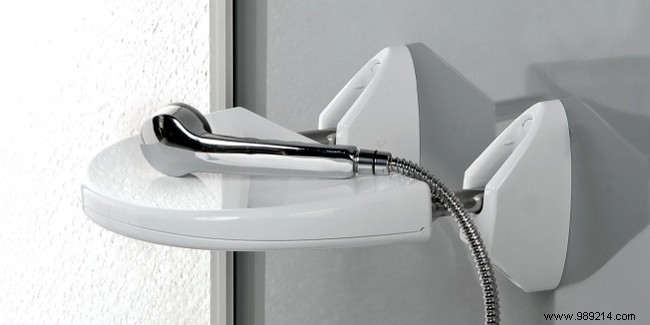2.5 million people aged 60 or over have a loss of autonomy according to INSEE data. There will be 4 million in 2050 according to the institute's projections. 43% of people over 50 are affected by a motor, visual or hearing disability. The aging of the population at work will make it even more difficult to keep elderly and/or disabled people at home. However, especially with advancing age, being able to live at home is the wish of a majority of people with reduced mobility. To do this, there are many solutions that make it possible to adapt a home when it is difficult to move around due to a disability or age.

Source: PMR bathroom PlaneteBain.com
The bathroom and the toilet are rooms that must be adapted for a person with reduced mobility.
A bathtub, for example, should preferably be replaced by an easily accessible shower, such as a walk-in shower, for example. The latter can be equipped with a bath seat and a non-slip coating to avoid any risk of falling.
Grab and hold bars, in showers and toilets, are also equipment that make these parts of water safer and that make their use much more comfortable for a person with reduced mobility.
In the toilets, the installation of a bowl adapted to the level of its height is also necessary for a use that is more suitable for a person who has difficulty moving around alone or who is in a wheelchair.
To be able to continue to evolve in their kitchen, a person with reduced mobility can benefit from installations and equipment intended to make their task easier.
First, it is necessary to adapt the work plan, in particular by choosing a height-adjustable model. Storage furniture should also preferably be adjustable in height and, if possible, be equipped with sliding doors that are much easier to handle when you have problems moving around and performing certain gestures.
Finally, when it comes to hobs, opt for induction hobs that are easier to use.
The bedroom is one of the rooms in the house where we spend a lot of time during a lifetime. This is why it is very important to adapt it for a person with reduced mobility and thus allow him to benefit from maximum comfort.
The bed should be easily accessible and above all comfortable. Many specific models for people who have difficulty moving exist on the market. From a single bed, the height of which is adjustable, to one equipped, for example, with a system for easy straightening up, or even fall protection barriers.
A home is not just about the inside. Its accessibility for a person with reduced mobility must also be redesigned. That's why some of the amenities in its exteriors are very useful.
For example, the aisles and the various accesses to the accommodation should be fitted out with suitable floor coverings, i.e. which do not slip or present any danger of falling in particular. In the same way, all steps or ledges that may hinder the movement of a person with reduced mobility must be removed.
Installing an access ramp at the door of the accommodation is also often very useful to facilitate and secure its access.
People with reduced mobility who live in accommodation with floors can continue to access it thanks in particular to the installation of a stairlift which facilitates the ascent of the steps but also greatly secures this movement.
Home automation, which refers to automated management techniques applied to housing, is very useful for adapting housing for a person with reduced mobility. It can take, for example, the form of automatic lighting of rooms in the house using detectors, thus avoiding falls. It can also be the centralized opening and closing of roller shutters for people who find it difficult to perform these operations manually.